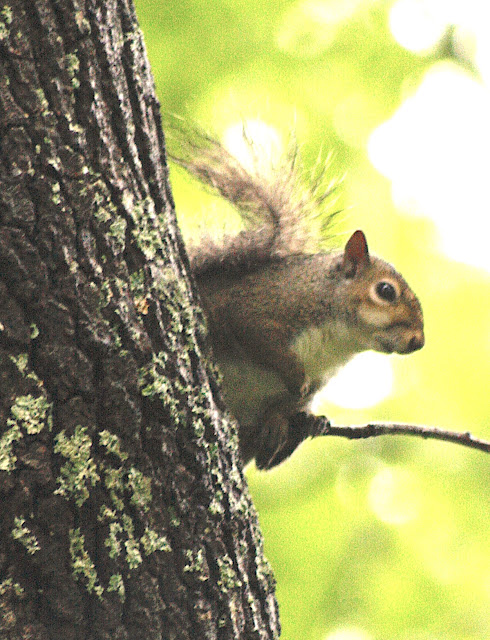I was walking along a wooded ridgetop one fall when I was a kid, when a young fox squirrel fell from a limb above me and landed with a thud not more than ten feet from my shotgun barrel. He didn't waste any time leaving but he would have been a goner if I had wanted to pull the trigger. I just couldn't do it. As a matter of fact that may be the only time I had a chance to shoot a squirrel that I didn’t. But dad had told me if I shot a squirrel from the rear, the shot from a shotgun would ruin most of the meat.
The little rascal had hidden in that treetop well enough to keep me from seeing him but his curiosity had caused him to lose his balance and his dignity at the same time. I shouldered my shotgun as he fled and let him escape. As I walked down the trail he sat on the limb of a nearby oak and barked at me. Or maybe it was his mate, wanting to chastise me for not shooting him. I learned a great deal about hunting when I was a kid, chasing squirrels in the fall after school. If you grew up in the rural Midwest chances are good you too learned to hunt by searching the branches of an oak-hickory woodlot or creek bottom for squirrels. Squirrels are efficient teachers for young hunters. And in the early fall, when green foliage is still as abundant as yellow leaves, squirrels have little trouble finding a place to hide.
Autumn hunting is a challenge but it is made easier when squirrels are working the hickories. On a crisp, still morning in the Ozarks, you can hear the grating of teeth on hickory nuts and the sound of small bits of hickory hulls falling to the forest floor. As the weather cools a bit more squirrels stay out later in the morning and come out earlier in the afternoon. When it's hot, their activity is lessened. But find a supply of hickory nuts this time of year and you'll usually find squirrels. Bits and pieces of gnawed hickory nuts beneath the tree give away their presence.
There are four methods of squirrel hunting that work all over the Ozarks. The first one of course is 'still-hunting'. When I was a youngster I'd take my old Iver Johnson shotgun down to the Tweed bottoms just off the Big Piney River and walk an old wagon trail where gray squirrels were abundant.
Occasionally I'd spot one by moving slowly along but when I'd reach a certain spot on a rocky hillside I'd find a big flat boulder and sit still enough to be taken for a part of the rock. Within 10 minutes, gray squirrels would forget there was an intruder and begin moving about. When one presented a good shot within 30 yards or so, the old shotgun would roar and the forest would be still again.
I learned if you stayed put, marking your downed quarry, that in 10 or 15 minutes things would return to normal again and squirrels would begin to scurry about. A still hunter could sometimes take three or four squirrels in less than an hour from one spot. And there was always much more to see, as other wildlife passed through and birds flitted through the nearby branches. When things were slow I would lay back on that rock and go to sleep, dreaming of hunting moose and bear in Canada someday. Still-hunting had many rewards. I learned so much out in the squirrel woods as a young boy, watching listening and exploring.
Right now and for the next 2 weeks, you will find a ton of walnuts under walnut trees everywhere. It looks like a banner year around my place for them and acorns alike. If you will call Hammons walnut company, 417 276 5181, they can tell you a place fairly close where you can sell walnuts for 20 dollars per hundred pounds. Bryan Hammon told me that they have never paid more than 15 dollars per hundred and they are working on the idea of having landowners who don’t pick them up to allow folks to come on their land and get them.
I am out of duck load shotgun shells, and I may make enough money to buy a few boxes, with the walnuts here on Lightnin’ Ridge.
If you want to receive fall issues of my outdoor magazine, or the one about the Ozarks, let me know. Just call 417 777 5227.




